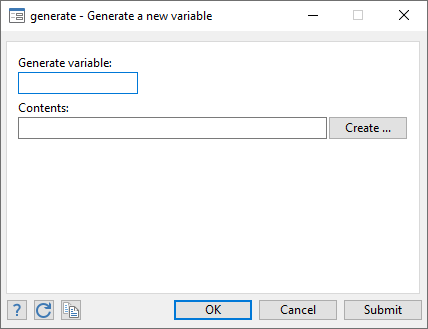

It can only be added to the “Data Editor” (Edit) window. However new variables cannot be added in this window.

A new tab will open to define the value 1 for Male and 2 for females. Variable Manager window in STATAĬlick on “Add Value” to add codes to each sub-category of the variable.įor example: to add information about gender, click “Add Value”. In the case of categorical variables define values by clicking on “Manage”. Variable manager tab in STATA main windowĪ new window will open, Variable list in STATAįor each variable, the properties are defined on the right-hand side: On the main Stata window, click on “ variable manager” to manage variables. destring to convert string to numeric and vice a versa.Where make1 is the new variable in the numeric form. To generate a new var, use the command: destring make, gen(make1) In order to replace “make”, we will use the command: destring make, replace Strings can be converted into numeric in two ways. This command is used to convert string variables into numeric variables and vice versa. Since a string cannot be used for analysis, it should be converted to numeric.Ĭheck the data set in “Variable Window” (See below), wherein the Name, Label, Type and Format of the variable are defined.įor example: in this case since the var “make” is registered as str18 and in order to compute it as numeric, it has to be converted into a numeric. However, sometimes the variables which have numerical value is taken as string variable. Once the data is entered into STATA, it automatically defines the storage type of the data. Similarly, “byte” size of numeric value would waste storage if it is saved as “double”. Note that since STATA stores information in the memory, the storage space should be used judiciously.įor example, the string female with a length of 6 would waste memory if stored as str20. Here str5 indicates its length.įor example, the male would be str4 (since the word ‘male’ has 4 characters) and females would be str6 (since the word ‘female’ has 6 characters). When you merge datasets by rows is important that datasets have exactly the same variable names and the same number of variables.In case of strings, they are stored at str#, i.e. Or we can merge datasets by adding columns when we know that both datasets are correctly ordered: finaldt <- cbind(dataset1, dataset2)
STATA CREATE NEW VARIABLE CODE
Using the code below we are adding new columns: finaldt <- merge(dataset1, dataset2, by="id") Merge dataset1 and dataset2 by variable id which is same in both datasets. However, for the function cbind is necessary that both datasets to be in same order. In case that datasets doesn't have a common variable use the function cbind. To add columns use the function merge() which requires that datasets you will merge to have a common variable. You can merge columns, by adding new variables or you can merge rows, by adding observations. If datasets are in different locations, first you need to import in R as we explained previously. Merging datasets means to combine different datasets into one.

STATA CREATE NEW VARIABLE HOW TO
Here is an example how to recode variable patients: df$patients <- ifelse(df$patients=150, 100, ifelse(df$patients=350, 300, NA))įor recoding variable I used the function ifelse(), but you can use other functions as well. Or we can also delete the variable by using command NULL: df$costs <- NULL Using dataset above we rename the variable: df$costs_euro <- df$costs Now we are interested to rename and recode a variable in R. Now we will create a new variable called totcosts as showing below: df$totcosts <- df$patients * df$costs Let create a dataset: hospital <- c("New York", "California")ĭf <- ame(hospital, patients, costs) Usually the operator * for multiplying, + for addition, - for subtraction, and / for division are used to create new variables. Variables are always added horizontally in a data frame. The common function to use is newvariable <- oldvariable. To create a new variable or to transform an old variable into a new one, usually, is a simple task in R.


 0 kommentar(er)
0 kommentar(er)
